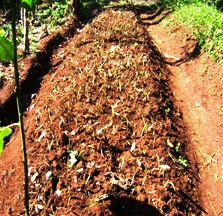This innovative farming methodcan contribute greatly to food and income
security, while helping in climate adaptation in Kenya, bearing in mind many river valleys have dried up due to global warming. Upland arrowroots
technology involves planting the crop in trenches lined with polythene paper
and filled with soil manure mixture at a ratio of 2:1. Planting trenches are
spaced at 0.5m. One acre of upland arrowroots technology grown tubers will accomodate 29,333 plants which will yield 29,333 tubers sold @ Ksh 15= Ksh 439995 gross income. The tubers are in high demand in Kenya
due to increased health consciousness .Arrow root leaves are rich in vitamins and minerals. They are a good
source of thiamin, riboflavin, iron, phosphorus, and zinc, and a very good
source of vitamin B6, vitamin C, niacin, potassium, copper, and manganese.
Corms are very high in starch, and are a good source of dietary fiber.
Varieties
There
are two main arrow root varieties namely
- Eddoe type – with small tubers; scientifically called colossia esculental. This is best for upland technology due to its productivity in low water.
- Dasheen type- with large tubers scientifically called colocasia esculenta.
Land
preparation in upland arrowroots technology
Arrow
roots are traditionally grown along the river valleys and in wet areas. With the upland
arrowroots technology they can now be grown away from river valleys.
Crop and Water management
Avoiding stepping on the
trench while weeding to prevent compaction. Tubers
grown using upland arrowroots technology requires ample moisture throughout the
growing season and therefore, Irrigation is required once per week. Soil ph of
5.5 to 6.5 is favourable.
Advantages
of upland arrowroots technology
1. Security: upland arrowroots
technology crop can be grown near homestead
2. Avoid damage from floods
3. Production is throughout the
year
4. Easy to enrich the soils by
adding manure and making the trenches
5. Time to maturity is shorter
6. With good management there is
higher yield
7. More suckers are produced by
upland arrow root
8. Upland arrowroots technology
has low labour requirement
Agronomic
requirements for upland arrowroots technology
·
Altitude:
900 to 1800 meters above sea level
·
Temperature:
Range of 21 to 300C.
·
Soils,
deep, well drained, loam, or silt
·
pH
5.5 to 6.5
·
It
performs poorly in frost conditions
Planting materials in upland arrowroots technology /conventional method
There
are four types of planting material that are used in cocoyams
production:
1. Side suckers from lateral proliferation of the main plant in the previous crop
2. Small corms (unmarketable)
resulting from the main plant in the previous crop.
3. Huli i.e. the apical 1-2 cm of the corm with
the basal 15-20 cm of the petioles attached;
- Corm pieces resulting when large corms are cut into smaller pieces.
Establishment
of 1 meter by 10 meter bed, 60 centimeter deep for upland arrowroots
technology
Requirements
1. Polythene sheet (heavy gauge)
10mx 2m wide
2. Planting comels 105 pieces
3. Manure- 4 wheelbarrows of
complete decomposed manure
4. Mulch ( during dry spell)
5. Labour 7man days
- Water 200 liters
Planting
and crop management in upland arrowroots technology
- Remove all weeds along the designated area and dig a straight trench 1 meter wide and 60 centimeters Deep
- Remove top soil (40cm) and subsoil(20cm) put them in separate side of the trench
- Put the polythene sheet to line the trench
- Mix the top soil with manure and return the mixture in the trench leaving a depression of about 10 cm then wet to saturation
- Plant the suckers in a spacing of 30cm by 30 cm inserting the plant up to 20 cm
- Spacing between beds should be 0.5M
- Mulch the area when planting during the dry spell
- Water once a week to maintain wetness
- Old and dry leaves should removed regularly
- Corms are ready to harvest between 6 to 8 month
Maturity and harvesting
upland arrowroot technology crop
Harvest when most leaves are yellow within 6 to 8 months. Leaves also shrink towards maturity.
Harvest when most leaves are yellow within 6 to 8 months. Leaves also shrink towards maturity.













